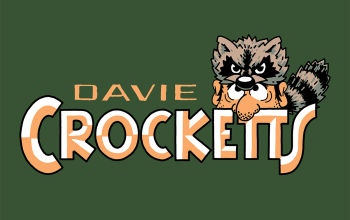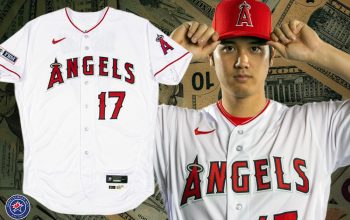 The origin of minor league baseball’s triple-A Salt Lake Bees’ nickname traces back a couple thousand years—to the Biblical “land of milk and honey.” Utah’s Mormon settlers called the state “Deseret,” a word from the Book of Mormon that means honey bee in the Jaredite language. It’s the reason the state uses beehive imagery everywhere, from highway signs to a sculpture in front of the capitol.
The origin of minor league baseball’s triple-A Salt Lake Bees’ nickname traces back a couple thousand years—to the Biblical “land of milk and honey.” Utah’s Mormon settlers called the state “Deseret,” a word from the Book of Mormon that means honey bee in the Jaredite language. It’s the reason the state uses beehive imagery everywhere, from highway signs to a sculpture in front of the capitol.
Though if pre-printing press European monks knew more honey trivia, the team name might have been different. According to Salt Lake Magazine:
“The beehive has been used as a symbol for thousands of years,” according to historian Mark Staker, an expert on early Mormon anthropology at the LDS Church’s Family History Center. “The Bible refers to the Promised Land as ‘the land of milk and honey.'”
Of course, there were no honeybees in the ancient Middle East.
“The European monks whose scriptoria kept the Bible in print before Gutenberg came along had no way of knowing that Biblical honey was most likely date honey and had nothing to do with bees. So they incorporated bees and the cooperative life of the hive into early Christian symbolism,” explains Staker.
However it came to be, it’s safe to say that it’s probably for the best that baseball teams in Salt Lake City over the years have been named for bees rather than dried fruit.
 The current baseball franchise in Salt Lake City debuted in 1994 as the Salt Lake Buzz after moving from Portland, Oregon. (I’m going to have to research this, but I’m pretty sure nearly every franchise in minor league baseball was once the Portland Beavers.) The team’s nickname and teal logo (because it was the ’90s and that was the law) were popular, but the team was forced to change for reasons beyond their control.
The current baseball franchise in Salt Lake City debuted in 1994 as the Salt Lake Buzz after moving from Portland, Oregon. (I’m going to have to research this, but I’m pretty sure nearly every franchise in minor league baseball was once the Portland Beavers.) The team’s nickname and teal logo (because it was the ’90s and that was the law) were popular, but the team was forced to change for reasons beyond their control.
“Everybody enjoyed it. It was a good logo, and it went over pretty well here,” said Steve Klauke, the team’s director of broadcasting, who just called his 3,000th game in more than 20 years as the voice of the Bees. “Unfortunately, Georgia Tech had trademarked Buzz for their team mascot and eventually filed suit against our old owners. I guess our old owners lost, so we had to change the name.”
“It doesn’t make any sense to me.” Klauke continued. “The mascot of an ACC team against a triple-A team 2,000 miles away, but so it goes.”
Ironically, the reason the team was not called the Salt Lake Bees when it moved from Portland in 1994 in the first place was a legal hurdle. The team’s owner, minor league baseball legend Joe Buzas, didn’t want to deal with the hassle of negotiating with another Bees team, the Midwest League’s single-A Burlington Bees.
“Burlington already had it,” Klauke said, “and that was something Joe wasn’t interested in dealing with. He wanted to have his own identity.”
 After the demise of the Salt Lake Buzz, the team had a name-the-team contest, which resulted in another bee-themed nickname. The Salt Lake Stingers debuted in 2001, the same year the team switched parent clubs from the Twins to the Angels. From 2001 to 2005, the team went with a logo that was, frankly, terrible (not to put too fine a point on it).
After the demise of the Salt Lake Buzz, the team had a name-the-team contest, which resulted in another bee-themed nickname. The Salt Lake Stingers debuted in 2001, the same year the team switched parent clubs from the Twins to the Angels. From 2001 to 2005, the team went with a logo that was, frankly, terrible (not to put too fine a point on it).
“I was not a big fan of the name or the logo,” Klauke said. “Let’s put it that way.”
The Stingers identity was also not popular with one very important person: “In 2005, the owner of the Utah Jazz, Larry Miller, purchased the ballclub, and he was not a big fan of that name,” Klauke said.
So new owner Larry Miller set about changing the name to the one he remembered from his childhood, the Salt Lake Bees. It’s a nickname that other teams in the city had used off and on since 1915. (The city’s original Pacific Coast League team is pictured above.)
“For years and years, from the mid-teens all the way up through probably the mid- to late-‘60s, any professional baseball team, whether it be Pacific Coast League or Pioneer League, was called the Bees,” Klauke said, “and [Miller] always thought the nickname should go back to that, because that’s the name that many people of his generation grew up with here.”
The centerpiece of the negotiation to bring the Bees name back to Utah was Salt Lake City’s special connection to the town of Nauvoo, Illinois, less than 30 miles from the other Bees’ home in Burlington, Iowa.
“Nauvoo, Illinois, is kind of a town that our local population, the LDS population, goes back to, because that’s where their trek west back to Utah began,” Klauke said. “So every year, in our game program, the Burlington Bees get a full-page ad and the ad basically says, ‘Hey when you come to visit Nauvoo, stop by and see a Burlington Bees game.'”

The franchise is celebrating its 20th anniversary in Salt Lake City this year. You can find their 20th anniversary logo everywhere from their social media avatar to their clearly overburdened helmet sundae cups. (According to an actual recent study, Utah ranks eighth in the nation in ice cream consumption per capita. Based on the photo above, I’m thinking they might not have cracked the top 20 without the help of Salt Lake Bees’ concessionaires.)
The Bees’ mascot is Bumble, who usually bats right handed, though there’s a rarely used left-handed version that I had to search hard to find in actual use. So far as I can tell, it doesn’t exist on team merchandise or anywhere on the team’s website, but the image below from the team’s Facebook page earlier this year shows it on the left sleeve of one of the team’s uniforms.
 The Bees wear their primary cap logo, the right-handed bee, during home games, but their road caps feature a classic interlocking SL for Salt Lake—not an SLC for Salt Lake City. According to Klauke, the Bees don’t use the word “City” in their name because the county of Salt Lake contributed to their stadium, so the moniker Salt Lake represents both the city and the county.
The Bees wear their primary cap logo, the right-handed bee, during home games, but their road caps feature a classic interlocking SL for Salt Lake—not an SLC for Salt Lake City. According to Klauke, the Bees don’t use the word “City” in their name because the county of Salt Lake contributed to their stadium, so the moniker Salt Lake represents both the city and the county.
After some legal wrangling and some false starts, the Bees have one of the most consistent identities in triple-A baseball. According to Klauke, the team has the second-longest continuous stretch of nickname, location, and affiliation in the Pacific Coast League, behind only the Colorado Springs Sky Sox. Strong colors, a clean look, and a nickname with a strong connection to place make the Bees’ identity a good one—dare I say, the Bees’ knees.
















